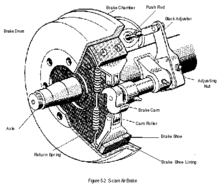Brake fade
Brake fade can be significantly reduced by appropriate equipment and materials design and selection, as well as good cooling.
Brake fade occurs most often during high performance driving or when going down a long, steep hill.
The reduction of friction termed brake fade is caused when the temperature reaches the "kneepoint" on the temperature-friction curve and gas builds up between disc and pad.
In this form of fade, the brake pedal feels firm but there is reduced stopping ability.
Fade can also be caused by the brake fluid boiling, with attendant release of compressible gases.
In many common brakes, a slight increase in friction can lead to wheel lockup with even light application.
Conversely, a slight decrease in friction can lead to severe brake fade.
[4] Many U.S. and third-world heavy vehicles use drum brakes due to their lower purchase price.
On heavy vehicles, air drag is often small compared to the weight, so the brakes dissipate proportionally more energy than on a typical car or motorcycle.
[citation needed] As the United States changed its FMVSS-121 rules for Class Eight trucks built in 2012 to reduce stopping distances by about 1/3rd there was no recommendation to use either drum or disc brakes in the current law.
However, if the brakes have been excessively hot for a prolonged period of time, glazing can occur on both of the friction linings of the shoes and pads.
When this happens, the contacting surfaces of the linings will have a smooth, shiny appearance, and will not perform as efficiently to slow the vehicle under braking.
This glazing can be easily removed by either gently using emery paper on them, or by driving the vehicle carefully whilst implementing light use of the brakes for several miles.
More recently disc brakes for trucks have been promoted listing features such as no fade, possible because they have no self-assist (self-servo).
[7] Railroads have been using disk brakes on passenger cars for more than 60 years, but coupled with a Rolokron anti-lock system to avoid the creation of flat spots (or "square wheels") when wheels lock and skid on the rail surface (audible as steady bang-bang-bang noise as a train goes by—not to be confused with the bang-bang...bang-bang...bang-bang sound made by wheels rolling over a rail joint).
The first development of modern ceramic brakes was made by British engineers working in the railway industry for TGV applications in 1988.
The objective was to reduce weight, the number of brakes per axle, as well as provide stable friction from very high speeds and all temperatures.
The result was a carbon-fibre-reinforced ceramic process that is now used in various forms for automotive, railway, and aircraft brake applications.
Improved friction is provided by lining materials that have a higher coefficient of friction than standard brake pads, while brake fade is reduced through the use of more expensive binding resins with a higher melting point, along with slotted, drilled, or dimpled discs/rotors that reduce the gaseous boundary layer, in addition to providing enhanced heat dissipation.
Adherents of gas emission have carried that belief to motorcycles, bicycles and "sports" cars, while all other disk brake users from the same automotive companies have no holes through the faces of their discs, although internal radial air passages are used.
Some high-performance racing calipers already include such brake heat shields made from titanium or ceramic materials.
